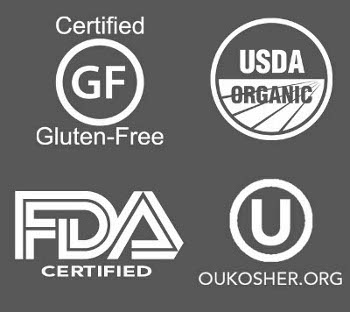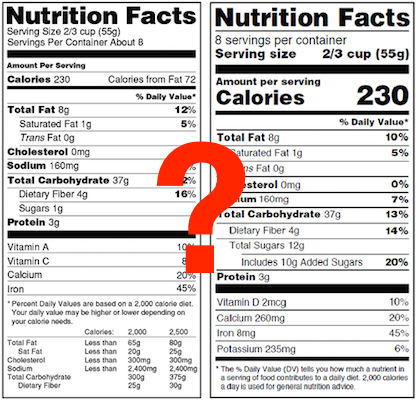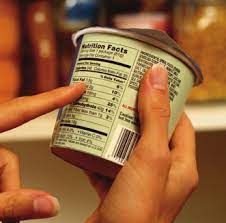Common Food Product Certifications and Labeling Terms
New food businesses are always excited to market their products with all the food label terms available in their arsenal.
Before you slap an “organic” or “gluten-free” label on your packaging though, make sure you know what it means, what you have to do in order to use it, and if it requires testing or certification.
What’s Inside
We’ll cover the main certifications here and get you ready to market your product accurately, safely, and in compliance with bodies like the FDA and USDA.
If you prefer to learn over video, we have a version on our YouTube Channel and embedded below:

A few of the common certifications you might see on food label.
We’ll also explain which claims are not regulated by these bodies - terms like “Natural”, “Vegan”, and “Raw”.
Keep in mind that you should always label your products in a truthful and not misleading manner. If you follow that rule of thumb, you should be OK.
Organic
Organic is a USDA designation for products that meet certain requirements.
Organic products come from animals that aren’t given any antibiotics or growth hormones and plants that don’t use most conventional pesticides, fertilizers made with synthetic ingredients, bioengineering or radiation.
An official certifier has to inspect the farm or product to make sure these guidelines are followed. There are also standards for handling and processing. If approved, your product can use the organic seal.
Beyond that, there are a few different levels of organic claims:
- 100% Organic. Products that are completely organic or made of only organic ingredients.
- Organic. Products with at least 95% of their ingredients being organic.
- Made with Organic Ingredients. Products with at least 70% of their ingredients being certified organic.
However, even without an organic certification, you can identify which ingredients are organic via your ingredient list.
Non-GMO
GMO means “genetically modified organism”. Specifically, it means a plant or animal created through genetic engineering (combining genes from different species to create a new one) in a lab environment that goes beyond traditional crossbreeding.
This area is a highly controversial debate that we can’t get into here, but many consumers worry about GMO products and hence food companies may want to market their products as “Non-GMO”.
Organic products are prohibited from using GMOs, so if your product is organic it is also by definition a non-GMO product.
To use a “Non-GMO Project Verified” seal, you have to be certified by the Non GMO Project. They will verify that each ingredient you use is non-GMO (with a 0.9% threshold, due to testing limitations) and perform annual audits.
The process can take quite some time (4-6 months) and also be somewhat expensive, of course depending on the ingredients you use in your product and their level of GMO risk.
On the flip side, as of 2022, food manufacturers with annual receipts of $2.5mm or more must disclose any GMO or "bioengineered" ingredients on their packaging. What used to be state by state rules are now national. Check out our blog post to learn all about labeling foods with bioengineered ingredients, disclosure requirements, exemptions, and how you know if this rule affects your products and business.
Gluten Free
Many new products claim to be gluten free or avoid gluten ingredients. However, gluten-free usually requires testing and certification.
The FDA governs the regulation of the term “gluten-free”, as you can see in the link above. According to the FDA’s 2013 regulation, gluten-free means that a food contains fewer than 20 parts per million of gluten. Even if none of the ingredients have gluten, the risk of cross-contamination in processing requires most products to be tested to ensure this standard of 20 ppm is met.
However, the FDA does not actually endorse any 3rd party gluten-free certification, so it’s a somewhat self-policing label. While the FDA does not require testing, you are responsible for ensuring that any foods bearing a gluten-free claim meet the 20 ppm requirement.
There is also no official seal or logo or font to be used to identify a food as gluten-free.
Vegan
“Vegan” has a relatively clear definition in the vegan and general community, but (like “natural”) does not have a formal definition from the FDA, USDA, or FTC for the purposes of labeling.
“Vegan” means the product doesn’t contain ingredients of animal origin, including milk, eggs, honey, and gelatin. Of course, meat, poultry and fish are not vegan either.
There are varying levels of veganism though, and you’ll sometimes see a product labeled as vegan, with a clarifying statement right below that might say “contains honey”, or something similar. That is acceptable in many eyes, since it is transparent to consumers and not misleading.
While not required, there are various certification programs that may establish more trust with your customers. These certifications are usually a bit more strict than the above definition of vegan, and may require that no animal testing has been done on any ingredients as well as some additional levels of scrutiny.
Kosher
Kosher foods have to be prepared from specific foods, by specific people and equipment, in a specific manner, and certified by one of many Kosher agencies.
However different Kosher certification agencies follow different standards, with some more and others less strict. Different certification and symbols mean different things, so if you are targeting a specific market it may be important to get not just any certification, but the right one for your target market.
On a high level, kosher means that foods don’t use pork products, meat and dairy cannot be combined, slaughter must be performed in a specific manner, and food must be produced with kosher utensils and machinery that are not used to make non-kosher foods or used for both meat and dairy products.
Natural
“Natural” is one of the least understood and most contested claims. Consumers associate it with something good, but there’s no formal definition from the FDA, or any association of food producers. The FDA requires labeling information to be “truthful and not misleading”, so it still shouldn’t be used willy-nilly.
"Natural" generally means being minimally processed and not containing added color, artificial flavor or synthetic substances. The USDA defines it, stating that “natural” meat, poultry, and egg products be minimally processed and contain no artificial ingredients. It does not, however, include any standards for farming practices. If using the label, a statement must accompany it explaining the meaning of the term (such as “no artificial ingredients; minimally processed”).
While the FDA hasn’t taken a stand, there have been a few cases in the courts. One company was forced into a multi-million dollar settlement for labeling their products as “natural” despite having GMO ingredients, artificial or synthetic ingredients. That can be taken as a guideline for what does and doesn’t define “natural” until the FDA and USDA take more a more formal approach on the matter.
“Natural” is not permitted in a product’s ingredient list except for in terms like “natural flavorings”.
Raw
Raw is a fairly new term that we’ve been seeing on food labels and in food marketing in general. As it is so new, it is also not governed by the FDA or USDA, or any other body. As always, any food claiming to be “Raw” should be truthful and not misleading, otherwise the FDA can take action against a false claim.
Raw foodists believe that you gain greater health and nutrition benefits from processing foods as minimally as possible. So, no pasteurization, and minimal heating and processing. On a more technical level, raw foods should not be heated above approximately 115 degrees.
Edit (August 18, 2015): With all the brands claiming to be raw, the industry has worked on creating standards for what that means. That initiative has been run by the International Center for Integrative Systems. Their project, Raw Food Certified, is offering certification for raw foods. Both websites offer more information on standards, certification, how it works, and more resources on the subject of raw foods.
Final Thoughts
That covers the most common certifications and food labels you might want to use. Of course, we could write a separate article on each one of these (we might!), but consider this an introduction.
If you plan on using one of these terms on your label make sure you understand what it means, what is required to use it, and never mislead your consumers.
If you have more questions, email us or leave a comment below.






